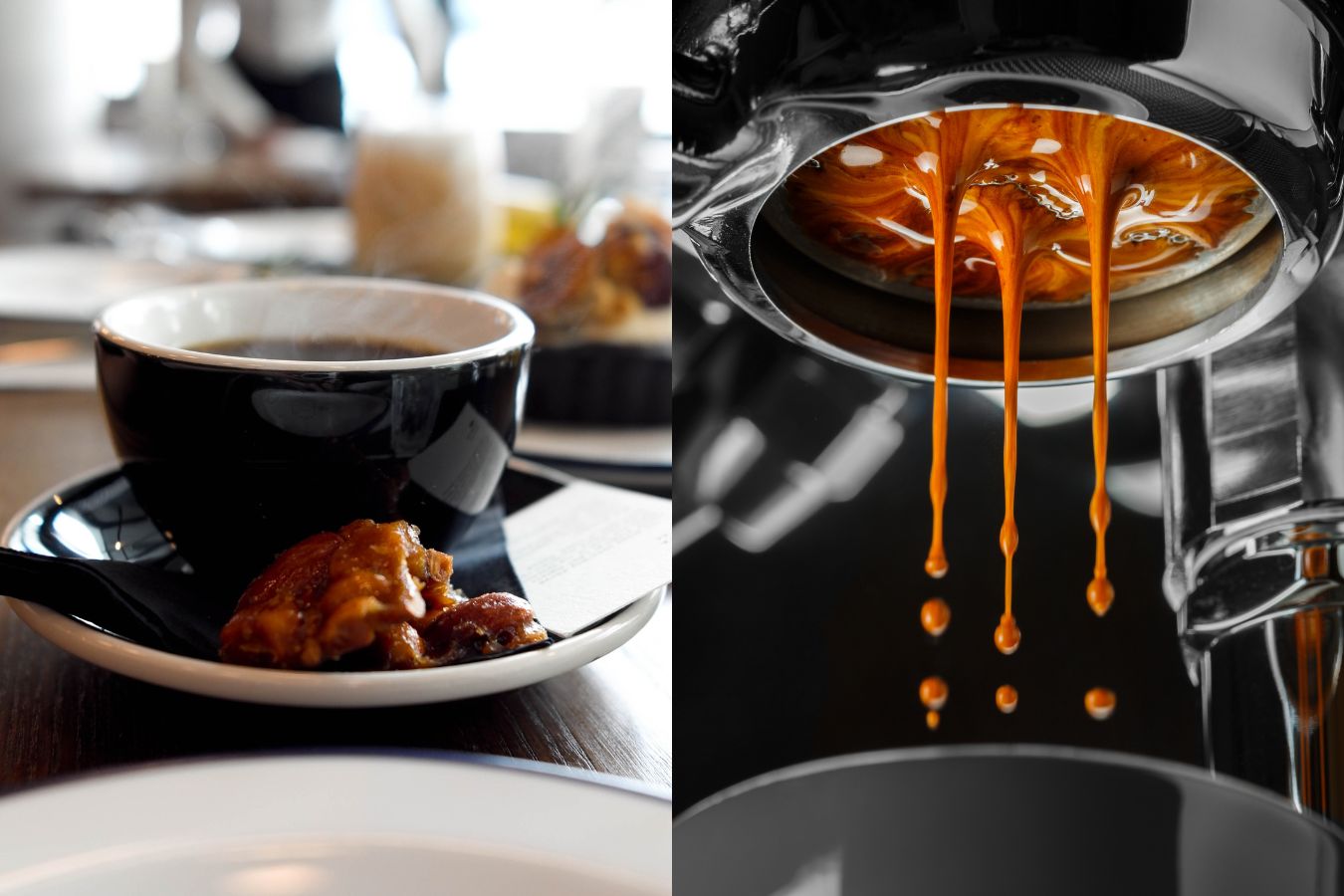How to Store SOE Single Origin Espresso for Long-Lasting Freshness
Recognizing Coffee Beans: the Journey From Coffee to Blended Coffee Beans

The Origins of Coffee: A Global Viewpoint
While you could believe of coffee as a contemporary staple, its beginnings trace back centuries, intertwining with cultures across the globe. The story starts in Ethiopia, where tale claims a goat herdsman named Kaldi found the stimulating impacts of coffee beans after noticing his goats frolicking energetically after consuming them.
As trade courses expanded, coffee made its method to Europe in the 17th century, swiftly acquiring popularity. Each society included its special twist to coffee preparation, enriching its history.
Growing and Harvesting of Espresso Beans
As coffee's trip developed, the focus changed to the farming and harvesting of particular bean ranges, specifically those used for espresso. You'll locate that coffee beans commonly come from Arabica or Robusta plants, each offering distinctive flavors. The perfect expanding conditions consist of high altitudes and rich, well-drained dirt, which boost the beans' top quality.
During the harvest, selecting approaches differ. In some regions, workers hand-pick ripe cherries, making sure only the very best fruit goes to handling. In various other locations, mechanical farmers are used, particularly on larger ranches. Timing is important; you intend to gather when the cherries get to peak perfection for maximum flavor.
When gathered, the beans are planned for handling, which is important in identifying their last taste. Understanding the cultivation and harvesting processes gives you understanding right into what enters into your favored espresso, improving your gratitude for each and every cup.
Handling Techniques: From Cherry to Bean
Currently that you have actually found out about gathering espresso beans, allow's explore how those cherries change right into the coffee beans you love. You'll see how various harvesting methods influence flavor, complied with by the essential steps of fermentation and drying. We'll damage down the milling and grading process that identifies your coffee's high quality.
Collecting Techniques Clarified
When it comes to coffee, comprehending harvesting techniques is necessary, since they directly impact the taste and high quality of the beans you take pleasure in. There are two main techniques: discerning picking and strip picking. Selective picking involves hand-picking just ripe cherries, guaranteeing you get the ideal top quality beans. This method commonly results in a richer flavor account, though it's even more labor-intensive. On the other hand, strip picking ways collecting all cherries at once, regardless of perfection. While it's quicker and more affordable, this can cause a mix of tastes, impacting the last product. Inevitably, the selection of harvesting technique can substantially influence your coffee experience, so it deserves knowing exactly how those beans made it to your mug.
Fermentation and Drying Out
After gathering, the following steps in processing coffee beans play a considerable function in shaping their taste. You'll locate that fermentation is crucial, as it aids damage down the mucilage surrounding the beans, improving their preference profile. Depending on the method, this process can last from a couple of hours to a number of days, with varying results based on temperature level and moisture.
As soon as fermentation is complete, drying complies with, which is equally crucial. You can select from sun-drying or mechanical drying methods. Sun-drying permits the beans to absorb tastes from the setting, while mechanical drying out guarantees constant wetness levels regardless of climate. Correct drying is necessary to protect against mold and preserve the beans' top quality, inevitably influencing your mug of coffee.
Milling and Grading Process
As fermentation and drying out set the stage for flavor advancement, the milling and grading procedure guarantees that just the most effective coffee beans make it to your mug. This stage entails eliminating the outer layers of the coffee cherry, consisting of the parchment and husk. After milling, the beans are sorted by size and weight, ensuring an uniform high quality. You'll find that grading assists determine defects and classify beans, which affects taste and aroma. High-quality beans obtain a greater quality, resulting in a richer coffee experience. When graded, the beans await product packaging and shipping, protecting their one-of-a-kind qualities. This precise process is necessary for supplying the remarkable taste you enjoy in every sip of your preferred mixture.
Toasting Strategies: Opening Taste Possible
When you roast coffee beans, the approach you pick can drastically affect the flavor profile. Understanding the partnership in between time, temperature, and toasting methods is vital to revealing the possibility of your mixture. Allow's check out exactly how these aspects collaborated to create the perfect mug.
Toasting Techniques Discussed
While you could assume that all coffee roasting approaches produce the very same results, the fact is that each strategy reveals one-of-a-kind flavor possibilities in the beans. Drum roasting utilizes a rotating drum to evenly disperse heat, improving caramelization and generating a balanced taste. Air roasting, on the other hand, flows hot air around the beans, advertising a lighter roast with obvious acidity.

Effect On Taste Profile
Different toasting methods not only influence the process yet likewise considerably influence the taste account of the coffee beans. Dark roasts, on the various other hand, bring out vibrant, great smoky tastes, occasionally concealing the bean's special attributes. Recognizing these subtleties assists you appreciate the artistry behind your cup of coffee, improving your general experience with every sip.
Time and Temperature Elements
To release the complete taste capacity of coffee beans, both time and temperature during the roasting procedure play substantial SOE functions. When roasting, you'll find that higher temperatures can quickly create tastes, however if you rush it, you could finish up with burned notes. Alternatively, reduced temperatures permit an extra progressive flavor development, showcasing the beans' one-of-a-kind features.

Timing is simply as essential; extending the roast as well long can lead to a loss of level of acidity and brightness, while also short a roast could leave the beans underdeveloped. Discovering that pleasant spot calls for method and trial and error. By changing these variables, you can expose the abundant, complex flavors concealed within each bean, developing a genuinely amazing coffee experience.
The Art of Mixing: Crafting Distinct Coffee Accounts

Start by choosing a base coffee that supplies a strong foundation. Then, pick complementary beans to enhance particular flavor notes. An intense Ethiopian bean can bring fruitiness, while an abundant Brazilian coffee includes body. Testing is crucial-- do not be worried to readjust proportions until you discover your excellent account.
As you mix, bear in mind that each mix narrates. You're not just making coffee; you're developing an experience. So, take your time, preference regularly, and enjoy the trip of uncovering your trademark mix.
Brewing Approaches: Just How Prep Work Influences Flavor
Blending coffee opens up a domain name of flavor opportunities, however how you make that blend can considerably affect your final mug. On the other hand, a pour-over highlights the coffee's clarity and illumination, perfect for showcasing fragile notes.
Coffee, with its high stress, creates a focused shot that highlights sweetness and crema. If you like a lighter brew, think about a cold brew approach; it generates a smooth, much less acidic taste.
Inevitably, experimentation is vital. Readjusting variables like water temperature, grind size, and make time can transform your coffee's account. Embrace the art of developing to uncover the flavors concealed in your coffee blends. The right method can raise your experience to brand-new heights.
The Future of Coffee: Sustainability and Innovation
As the coffee market advances, sustainability and innovation are ending up being essential for attending to environmental difficulties and conference customer demands. You'll discover that even more coffee firms are adopting environment-friendly methods, from sourcing beans ethically to executing sustainable farming techniques. These changes not just assist the world yet likewise enhance the top quality of the coffee you appreciate.
You could see advancements like eco-friendly product packaging and water-saving brewing methods that decrease waste. Advanced technology, such as blockchain, is likewise ending up being preferred, making certain openness in the supply chain, which permits you to map your coffee back to its beginnings.
Furthermore, purchasing regional neighborhoods and sustaining farmers with reasonable trade efforts promotes a more sustainable coffee environment. As you sip your next cup, keep in mind that your choices can add to a brighter future for coffee. By selecting lasting brands, you're not just delighting in a beverage; you're making a positive effect on the globe.
Often Asked Inquiries
What Is the Difference In Between Arabica and Robusta Beans?
Arabica beans are smoother, sweeter, and have a higher acidity, while robusta beans are more powerful, a lot more bitter, and consist of more high levels of caffeine. When making your coffee., you'll notice these distinctions in flavor and fragrance.
Exactly How Does Elevation Affect Coffee Bean Taste?
Altitude effects coffee bean flavor significantly. Higher altitudes produce beans with brighter acidity and complicated tastes, while lower altitudes typically yield beans that are much heavier and much less nuanced. You'll observe these differences in your cup!
What Are the Wellness Perks of Drinking Coffee?
Consuming coffee can enhance your power, improve psychological emphasis, and even boost physical efficiency. It's abundant in antioxidants, might lower the danger of particular illness, and can advertise a healthier metabolism when eaten in small amounts.
Can Coffee Beans Be Reused for Developing?
Yes, you can recycle coffee beans for brewing, however the taste could be weak. If you take pleasure in experimenting, try recycling them in various ways, like chilly mixtures or including in healthy smoothies for an added kick.
How Should I Store Coffee Beans for Quality?
To maintain your coffee beans fresh, save them in an airtight container in a great, dark area. Stay clear of exposing them to heat, wetness, or light, as these elements can promptly degrade their flavor and scent.
Recognizing Coffee Beans: the Trip From Espresso to Blended Coffee Beans.
Now that you've learned regarding gathering coffee beans, allow's explore how those cherries transform into the coffee beans you love.When you roast coffee beans, the technique you select can substantially influence the flavor profile - Single Origin Espresso.While you may believe that all coffee roasting techniques produce the same results, the truth is that each strategy reveals unique flavor possibilities in the beans.Various toasting techniques not only influence the procedure yet additionally substantially influence the taste profile of the coffee beans